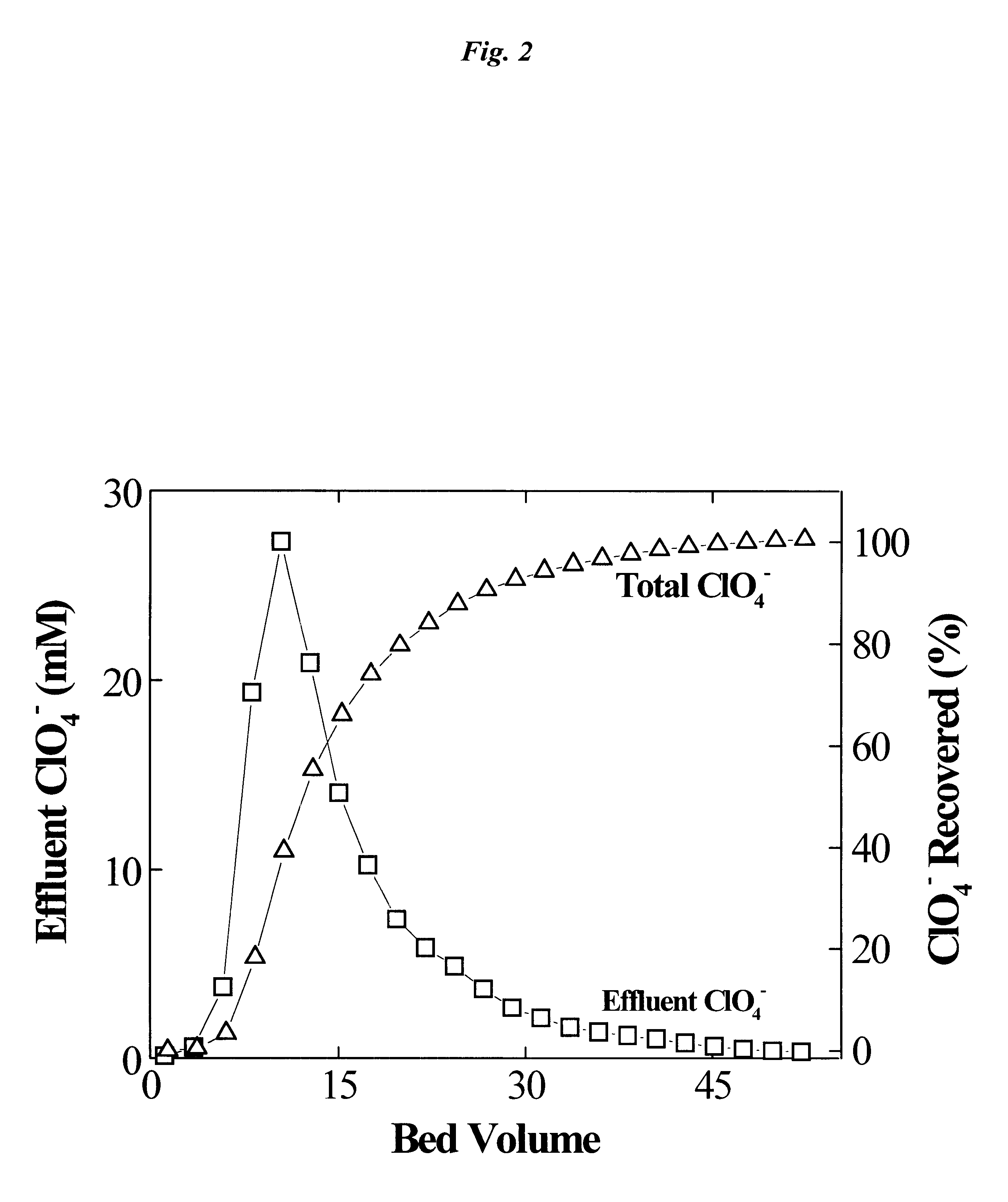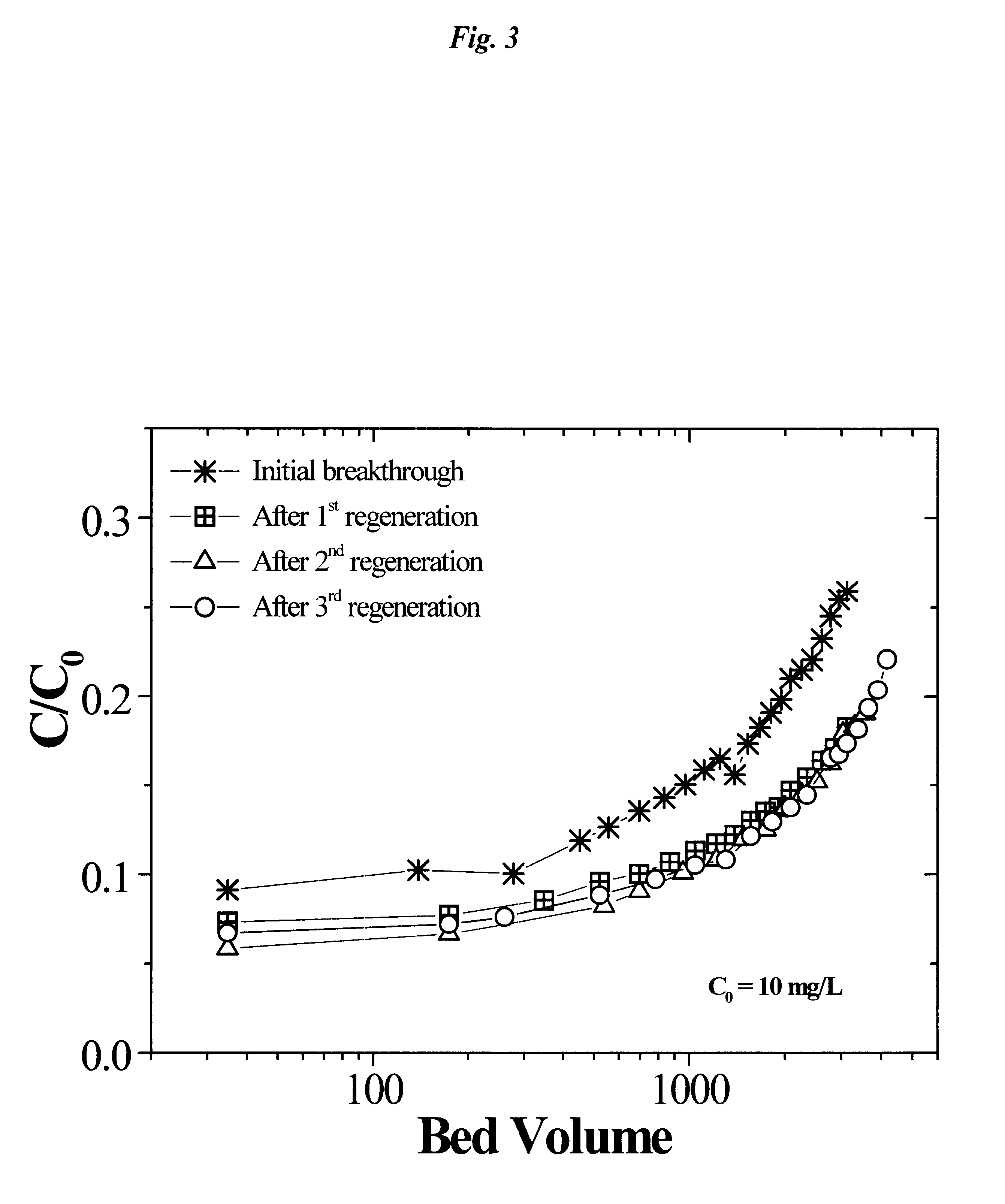Regeneration of strong-base anion-exchange resins by sequential chemical displacement
a strong-base anion exchange resin and sequential technology, applied in the direction of anion exchangers, ion-exchanger regeneration, chemistry apparatus and processes, etc., can solve the problems of difficult removal, low recovery rate, and high salt soluble content, and the chronic exposure data have not been definitively related
- Summary
- Abstract
- Description
- Claims
- Application Information
AI Technical Summary
Problems solved by technology
Method used
Image
Examples
example 1
This example shows the elution and recovery of perchlorate on a Purolite.TM. A-520E resin column (10.times.22 mm) during the regeneration by using the tetrachloroferrate displacement (Comparative Example 1). Results shown in FIG. 2 indicated a rapid desorption of adsorbed perchlorate on the Purolite.TM. A-520E resin and a nearly 100% recovery of adsorbed perchlorate. Elution was essentially complete after approximately 45 bed volumes of displacement with tetrachloroferrate, and a good mass balance was observed.
example 2
This example illustrates the performance of a commercial nitrate-selective anion exchange resin (Purolite.TM. A-520E) for perchlorate removal after repeated regeneration (3 times) with the tetrachloroferrate displacement technique. The data in FIG. 3 shows the perchlorate breakthrough (C / C.sub.0) in a small packed column (10.times.22 mm) running at 30 mL min.sup.-1 in the laboratory. The C / C.sub.0 is the ratio of effluent perclilorate concentration versus the initial influent concentration of 10 mg L.sup.-1 in a synthetic test solution (consisted of 3 mM NaHCO.sub.3, 1 mM CaCl.sub.2, 0.5 mM MgCl.sub.2, 0.5 mM Na.sub.2 SO.sub.4, and 0.5 mM KNO.sub.3). Results indicated a nearly identical breakthrough of perchlorate after repeated regeneration without any apparent loss of performance. In fact, the regenerated column appeared to perform slightly better than the initial column which may be due to a thorough washing and opening of additional micropores and adsorption site on the A-520E r...
example 3
This example demonstrates the performance of a highly-selective bifunctional anion exchange resin, D-3696, prepared by Purolite International (to specifications provided by Oak Ridge National Laboratory, U.S. patent application Ser. No. 08 / 922,198) for perchlorate removal after repeated regeneration (7 times) with the tetrachloroferrate displacement technique. The data in FIG. 4 show the perchlorate breakthrough (C / C.sub.0) in a small packed chromatographic column (10.times.22 mm) running at 30 mL min.sup.-1 in laboratory. Note that the resin had been used for groundwater treatment at a field site in northern California and was a subsample from the resin recovered from the field. The C / C.sub.0 is the ratio of effluent perchlorate concentration versus the initial influent concentration at 10 mg L.sup.-1 in a synthetic test solution (consisted of 3 mM NaHCO.sub.3, 1 mM CaCl.sub.2, 0.5 mM MgCl.sub.2, 0.5 mM Na2SO.sub.4, and 0.5 mM KNO.sub.3). Results of ClO.sub.4.sup.- breakthroughs on...
PUM
| Property | Measurement | Unit |
|---|---|---|
| temperatures | aaaaa | aaaaa |
| dry-weight equivalent | aaaaa | aaaaa |
| concentration | aaaaa | aaaaa |
Abstract
Description
Claims
Application Information
 Login to View More
Login to View More - R&D
- Intellectual Property
- Life Sciences
- Materials
- Tech Scout
- Unparalleled Data Quality
- Higher Quality Content
- 60% Fewer Hallucinations
Browse by: Latest US Patents, China's latest patents, Technical Efficacy Thesaurus, Application Domain, Technology Topic, Popular Technical Reports.
© 2025 PatSnap. All rights reserved.Legal|Privacy policy|Modern Slavery Act Transparency Statement|Sitemap|About US| Contact US: help@patsnap.com



